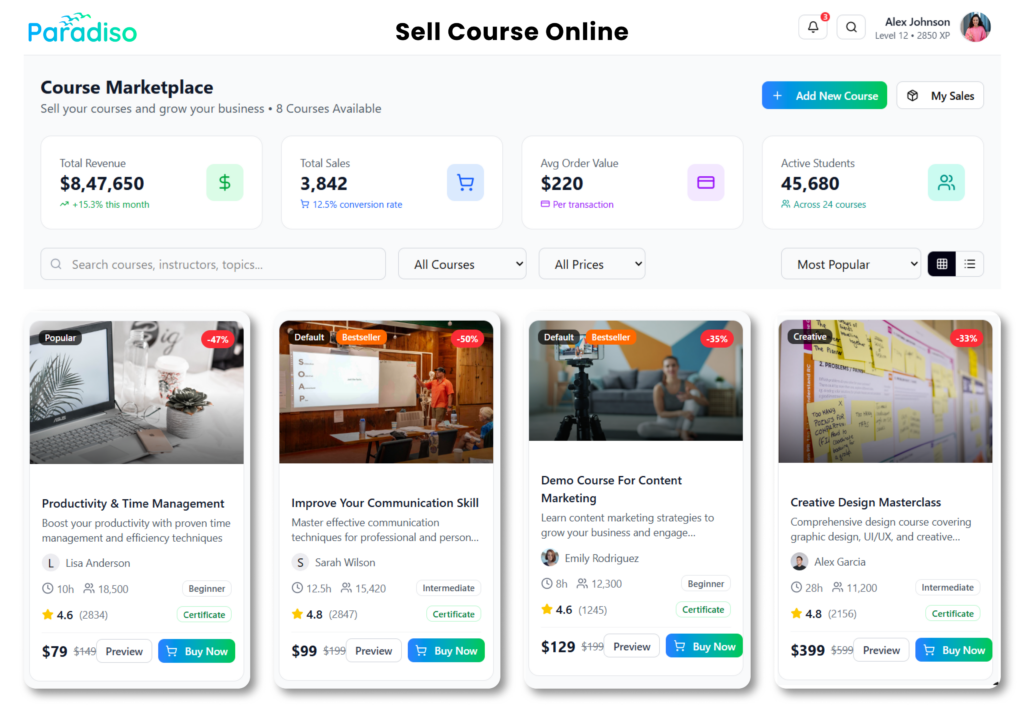Are you passionate about sharing your knowledge and expertise with the world? Have you ever thought about creating and selling your training content online? In today’s digital age, the possibilities are endless, and the demand for online courses and educational materials is skyrocketing. Whether you’re an experienced professional, a skilled hobbyist, or an expert in a specific field, turning your expertise into a profitable online business is within your reach.
But where do you start? How can you ensure your training content stands out and attracts eager learners? Fret not, because we’ve got you covered! In this article, we’ll unveil nine invaluable tips to help you create high-quality training content and effectively market and sell it online. So, buckle up and prepare to embark on a journey that transforms your knowledge into a lucrative online venture. Get ready to captivate minds, inspire learners, and build your digital empire!
9 Valuable Tips For Selling Online Training Courses
1. Selecting A Course Topic
Selecting a profitable course niche is crucial for your online course success. Consider the following points:
Choosing a profitable niche
- Research market demand: Use tools like Google Trends to identify popular search terms and topics.
- Analyze competition: Assess existing courses in your niche and look for gaps or unique value you can offer.
- Identify target audience: Define and understand their needs and aspirations.
- Align with your expertise: Choose a topic that aligns with your qualifications, experience, and passion.
Researching market demand and competition:
- Conduct keyword research: Use tools like Google Keyword Planner to gauge interest in your topic.
- Look for existing courses: Analyze competitors’ content, reviews, and ratings to understand what works well.
- Analyze target audience needs: Engage with potential students to gain insights into their pain points and preferences.
- Assess market saturation: Determine if there is room for differentiation and target underserved segments.
Aligning your expertise with market needs:
- Identify unique value proposition: Define what sets you apart from other instructors.
- Conduct a skills gap analysis: Determine where your expertise can be most valuable.
- Seek feedback and validation: Gather input from peers, experts, and potential students.
- Stay updated and adaptable: Monitor industry trends and adapt your course content accordingly.
2. Develop Your Course Content
Outlining course modules and lessons:
When developing your training content, creating a well-structured outline that guides your students through the learning journey is essential. Consider the following:
- Define course modules: Divide your course into logical modules or sections that cover different aspects of the topic. This helps organize the content and makes it easier for students to navigate.
- Outline lessons within modules: Break down each module into lessons focusing on specific subtopics or skills. This ensures a step-by-step learning process and helps students grasp the concepts effectively.
- Arrange content hierarchy: Determine the order in which the lessons should be presented to ensure a logical progression of knowledge. Start with foundational concepts before moving on to more advanced topics.
Creating engaging and valuable content:
- Use various teaching methods: To sell courses online, incorporate a mix of text, visuals, and interactive elements to cater to different learning styles. This can include videos, audio recordings, infographics, and case studies.
- Make it practical and applicable: Provide real-world examples, exercises, and practical assignments that allow students to apply their knowledge. This helps them see the relevance of the content and boosts engagement.
- Offer actionable insights: Provide practical tips, strategies, or frameworks that students can implement immediately. This adds value to their learning experience and makes the course more impactful.
Incorporating multimedia elements (videos, quizzes, worksheets):
- Videos: Create instructional videos to explain complex concepts, demonstrate processes, or share expert insights. Visual content is highly engaging and helps students grasp information more easily.
- Quizzes and assessments: Include quizzes and assessments at the end of each module or lesson to reinforce learning and evaluate students’ understanding. This provides them with immediate feedback and encourages active participation.
- Worksheets and downloadable resources: Provide worksheets, checklists, templates, or other resources that students can use to practice and apply what they’ve learned.
3. Choose the Right Platform
Comparing the best online course platforms:
When selling courses online, selecting the right platform is crucial. Consider the following popular platforms:
- Paradiso LMS : A comprehensive platform offering a range of course creation, marketing, and sales features. It provides flexibility, customization options, and robust integrations to enhance the learning experience.
- Udemy: A well-known marketplace with a large student base. Udemy provides a built-in audience but has stricter pricing and course approval policies.
- Teachable: A user-friendly platform that allows you to create and sell courses independently. It offers customization options and marketing tools but needs a built-in audience.
- Thinkific: A comprehensive platform that provides course creation, marketing, and sales features. Thinkific offers more customization options and advanced integrations.
Evaluating features, pricing, and customization options:
- Features: Assess the features offered by each platform, such as video hosting, course analytics, student engagement tools, and marketing integrations. Consider which features are essential for your course’s success.
- Pricing: Compare the pricing models of different platforms. Some charge a transaction fee per sale, while others offer monthly subscription plans. Consider the pricing structure and how it aligns with your revenue goals.
- Customization options: Consider the level of customization each platform provides. Look for options to personalize your course website, branding, and student experience. This helps create a cohesive and unique learning environment.
Selecting a platform that aligns with your course goals:
- Consider your course format: Some platforms are more suitable for video-based courses, while others offer more text-based or interactive content flexibility. Choose a platform that supports your preferred course format.
- Assess marketing and sales capabilities: Evaluate the platform’s marketing and sales features. Look for options to offer discounts, create coupon codes, integrate with email marketing software, and track conversions.
- Review user experience: Research user reviews and testimonials to gauge the overall user experience on each platform. Look for feedback on ease of use, customer support, and platform stability.
4. Set Up Your Course Website
Securing a domain name and hosting:
- Choose a domain name that reflects your course or brand and is easy to remember.
- Register the domain name with a reliable domain registrar.
- Select a hosting provider with reliable and secure hosting services for your course website.
- When choosing a hosting provider, Consider server speed, storage, and customer support.
Designing an attractive and user-friendly website:
- Use a visually appealing and professional design that aligns with your course topic and target audience.
- Ensure easy navigation and intuitive user experience on your website.
- Organize your content logically and be user-friendly with clear sections and menus.
- Use high-quality images, videos, and graphics to enhance the visual appeal of your website.
Integrating payment gateways and course delivery systems:
- Set up secure and reliable payment gateways to accept payments from your students.
- Consider popular payment gateways like PayPal, Stripe, or other platforms that align with your needs.
- Choose a course delivery or learning management system (LMS) that allows you to deliver and manage your course content effectively.
- Integrate your website’s payment gateway and course delivery system seamlessly for a smooth user experience.
5. Optimize Your Course for Sales
Writing compelling course descriptions and headlines:
- Craft attention-grabbing headlines that highlight the unique value proposition of your course.
- Write persuasive and descriptive course descriptions that communicate the benefits and outcomes of taking your course.
- Use engaging language, emphasize key features, and address potential pain points or challenges your course solves.
Highlighting the benefits and outcomes of your course:
- Clearly communicate the benefits and outcomes students can expect from your course.
- Highlight how your course solves their problems, improves their skills, or helps them achieve their goals.
- Use bullet points or short paragraphs to present the key benefits in a scannable format.
Incorporating testimonials and social proof:
- Include testimonials from satisfied students or industry experts who have experienced positive results from your course.
- Showcase social proof such as positive reviews, ratings, or endorsements from reputable sources.
- Place testimonials strategically on your website to build trust and credibility.
6. Create a Marketing Strategy
Identifying your target audience:
- Define your target audience based on demographics, interests, and needs.
- Conduct market research to understand their pain points, preferences, and motivations.
- Use this information to tailor your marketing messages and strategies to resonate with your target audience.
Developing a content marketing plan (blog posts, videos, podcasts):
- Create valuable and informative content related to your course topic.
- Develop a content calendar and publish regular blog posts, videos, or podcasts that provide insights, tips, or tutorials.
- Share your content on relevant platforms and engage with your audience to establish your expertise and attract potential students.
Utilizing email marketing, social media, and paid advertising:
- Build an email list and leverage email marketing campaigns to nurture relationships with potential students and promote your course.
- Utilize social media platforms where your target audience is active. Share engaging content, interact with your followers, and run targeted advertising campaigns.
- Consider paid advertising on platforms like Google Ads or social media to reach a wider audience and generate leads.
7. Price Your Course
Evaluating market pricing trends:
- Research and analyze the pricing of similar courses in your niche.
- Consider factors like course length, content depth, and your expertise when evaluating market pricing trends.
Determining the value of your course:
- Assess the unique value, expertise, and benefits your course provides students.
- Consider the transformation or outcomes your course offers and the investment students make in their personal or professional growth.
Offering competitive pricing and discounts:
- Set a competitive price for your course that aligns with its value and market trends.
- Consider offering introductory or limited-time discounts to attract new students.
- Provide tiered pricing options or bundle packages to cater to different budgets and needs.
8. Launch Your Course
Building anticipation with pre-launch strategies:
- Generate buzz and excitement by teasing your course content through social media posts, email newsletters, or sneak peeks.
- Offer exclusive early-bird discounts or bonuses to incentivize early enrollment.
- Collaborate with influencers or industry partners to amplify your launch reach.
Creating a launch timeline and promotional calendar:
- Plan a launch timeline that outlines key activities and deadlines leading up to the course launch.
- Develop a promotional calendar with specific marketing strategies and tactics for each launch phase.
- Allocate resources and set clear goals to ensure a well-executed and successful launch.
Hosting webinars, challenges, or free mini-courses:
- Conduct webinars or live Q&A sessions to engage with your audience, address their questions, and showcase the value of your course.
- Offer free mini-courses or challenges that taste your content and demonstrate your expertise.
- Leverage these opportunities to build trust, establish credibility, and generate interest in your paid course.
9. Nurture Your Students and Generate Referrals
Providing excellent customer support:
- Offer prompt and helpful customer support to address any questions or concerns from your students.
- Provide multiple communication channels such as email, discussion forums, or live chat to ensure accessibility and responsiveness.
Engaging with students through discussion forums and Q&A sessions:
- Create a dedicated online community or discussion forum where students can connect, share insights, and seek support.
- Host periodic Q&A sessions or live office hours to address student queries and foster a sense of community.
Encouraging satisfied students to leave reviews and refer others:
- Request reviews and testimonials from satisfied students who have completed your course.
- Offer incentives or referral programs to encourage students to refer others to your course.
- Leverage social proof and positive word-of-mouth to attract new students and build your reputation.
Conclusion
Selling courses online requires careful planning and execution. By utilizing Paradiso LMS’s comprehensive features and customization options, you can create an engaging course website, optimize your course for sales, implement a strategic marketing plan, and nurture your students for long-term success in the online learning industry.














